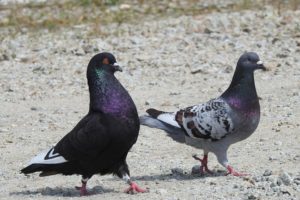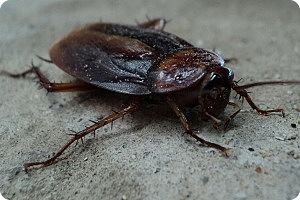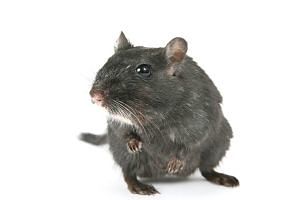Prairie dogs are burrowing rodents that can be difficult to remove and control in Colorado. Prairie dogs are rodents within the squirrel family. There are five species of prairie dogs native to North America but only three species of prairie dogs live in Colorado. The black-tailed prairie dog lives in the Denver / front range area and on the eastern plains, the Gunnison prairie dog lives in the southwest third of the state, and the white-tailed prairie dog lives in the northwest third of the state.
Prairie dogs live in prairies and fields where there is a lot of grassland. They create large holes and burrows to live in from the surface of the land deep into the ground.
The good and the bad of prairie dogs and their burrows
Prairie dog burrowing activity can be very destructive to the land farmers and ranchers own. They compete with livestock for grass and crops, and the large prairie dog holes can be harmful to livestock. Prairie dog holes can cause horses and cattle to break their legs. In addition, prairie dogs can carry plague infected fleas. Domestic animals and humans can then catch the plague from the fleas carried by prairie dogs.
However, their burrows can benefit local ecosystems. Their colonies help sustain over 150 other species, including ferrets, eagles, coyotes, foxes, bobcats, badgers, and more. In addition, prairie dogs help aerate and fertilize the soil, allowing for a greater diversity of plants to grow.
When deciding to remove and control a prairie dog colony its important to evaluate the pros and cons of prairie dogs and how they are affecting your land.
Identification and signs of prairie dogs
Prairie dogs are small, furry, somewhat fat little animals. Adult prairie dogs are 11 to 13 inches tall and have hairy tails that are 3 to 4 inches long. They typically weigh between 2 to 4 pounds. They have sandy, reddish colored fur, a whitish colored belly, large black eyes, short ears, broad, rounded heads, and short legs with claws. Prairie dogs make little chirping sounds that sound like barking dogs.
Prairie dogs dig very complex burrows that include rooms and tunnels. The entrance to a prairie dog burrow looks like a large dome shaped mound with a funnel type opening measuring about 3 to 4 inches in diameter. The entrance hole leads down to a steeply slanted tunnel that is three to fourteen feet deep and four to eight inches in diameter. The tunnel then levels off for another 20 to 100 feet. The prairie dog tunnels also have side chambers for nesting, storage, and escape from predators or flooding.
Prairie Dog Removal and Control
There are several options available to remove and control prairie dogs. These options include trapping, physical barriers, shooting, rodenticide baits, and fumigants . Not all options are available in all areas.
Trapping
Prairie dogs can be trapped with a baited double-door cage trap. Some of the best baits to use in the trap include carrots, apples, or horse sweet feed mix. Traps are set near, or at, the prairie dog entrance hole. Trapping is labor intensive and time consuming. Generally this option is used when relocation of the prairie dogs is the goal. However, relocation is an issue. Relocation sites are difficult to find and a permit is required before prairie dogs can be relocated.
Physical Barriers to prevent prairie dogs
Physical or vegetative barriers can be placed to prevent prairie dogs from invading or reinvading land. Barriers are expensive and not very effective. Physical barriers include fencing made with wood, vinyl, or masonry. Physical barriers should be at least 3-feet tall, extend into the ground 2-3 feet, and be opaque. Vegetative barriers include shrubs or mid to tall height grasses. Shrub depth should be 10 to 20 foot wide. Grassy barriers should be 200 to 300 foot wide. When using barriers, some removal of prairie dogs that breach the barrier will be needed. Pea gravel or chicken wire can be used to prevent reopening of new burrows by other prairie dogs.
Shooting
Shooting prairie dogs will sometimes manage small populations. It removes individual animals and disrupts reproductive activities. Follow good hunter safety practices and local regulations when using shooting to manage prairie dog colonies.
Rodenticide Baits
Two types of rodenticide (poison) grain baits can be used for prairie dog control in Colorado – anticoagulant baits and zinc phosphide baits.
All poison grain baits for prairie dog control are restricted use pesticides. Many of the restrictions and limitations on use are necessary to prevent death or injury to non-target animals including birds, wildlife, pets, and livestock. These baits can only be used for prairie dogs on rangeland, rangeland and pasture, or rangeland and adjacent non-crop area. Colorado State Extension
Prairie dogs would rather eat green grass than bait. Poison grain baits are effective only when green grass has become dry and dormant. Generally, baiting in the fall is most successful because prairie dogs eat grass seeds to build fat reserves for the winter.
Fumigants
Three fumigants can be used for prairie dog control in Colorado: Aluminim phosphide, a USDA gas cartridge, and carbon monoxide. Aluminum phosphide products are classified as restricted use pesticides. Gas cartridges and carbon monoxide are classified for general use. Every opening of each prairie dog burrow has to be covered to contain the poison gas for the gas to be effective.
Aluminum phosphide
Aluminum phosphide is highly toxic and can be dangerous to use. It generally comes in pellet form. Aluminum phosphide cannot be used on residential properties, nursing homes, schools, daycare facilities, and hospitals. It also cannot be used in a prairie dog burrow system that is within 100 feet of a building that is, or will be, occupied by humans or domestic animals. Aluminum phosphide can be used on agricultural areas, orchards, non-crop areas, golf courses, athletic fields, airports, cemeteries, rights-of-way, earthen dams, parks and recreational areas and other non-residential institutional or industrial sites. Pellets or tablets must be applied directly to underground burrow systems. We do not recommend using aluminum phosphide for prairie dog control.
Gas cartridges
Gas cartridges are ignited with a fuse and burn, producing smoke and carbon monoxide. The carbon monoxide kills the prairie dogs. Gas cartridges are used in open fields, non-crop areas, rangelands, reforested areas, lawns and golf courses. It’s important to be careful, the burning cartridges are capable of causing severe burns, and can ignite dry grass, leaves and other combustible material. Do not use near buildings or very dry grassy areas. We do not recommend using gas cartridges.
Carbon monixide
Carbon monoxide utilizing a Rodent Control Machine or device. The carbon monoxide asphyxiates the prairie dogs and is a very effective approach to controlling prairie dogs. This is what we use.
Benefits of treating with Carbon Monoxide include:
-
-
-
-
-
-
-
-
-
- Direct targeting of prairie dogs within the burrow system
- No reliance on bait acceptance.
- No secondary toxicity concerns for scavengers.
- Seldom requires handling of prairie dogs after treatment.
- Highly effective.
- Designated as a pest control device by the EPA.
-
-
-
-
-
-
-
-
Call a professional to control prairie dogs
The best way to remove and control prairie dogs is to call a professional to get rid of them. Professional pest control operators are experts who have the tools and the knowledge to get rid of prairie dogs safely and humanely.
Rocky Mountain Bird and Pest Solutions only uses methods of control approved by the State of Colorado.





Leave a Reply
Your email is safe with us.